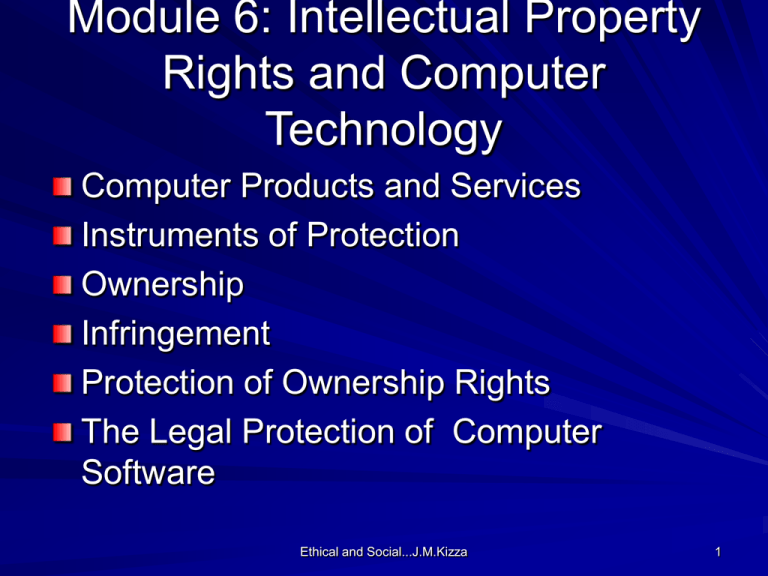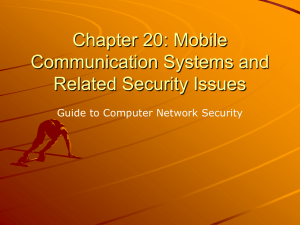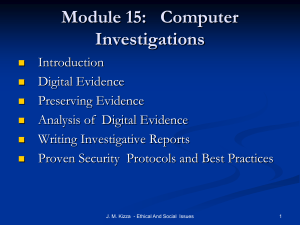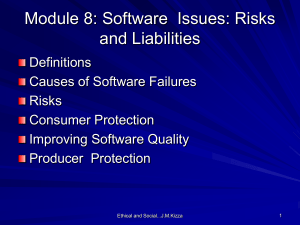chapter 6
advertisement

Module 6: Intellectual Property Rights and Computer Technology Computer Products and Services Instruments of Protection Ownership Infringement Protection of Ownership Rights The Legal Protection of Computer Software Ethical and Social...J.M.Kizza 1 Computer products and services Computer products – Have a tangible form – Have intrinsic value Computer services – Have intrinsic value – Have no tangible form Computer software – A set of logical instructions in four forms: Ethical and Social...J.M.Kizza 2 Computer products and services… Logical map Source code Object code Executable code – Has two forms Product Service – May not have a tangible form Ethical and Social...J.M.Kizza 3 Computer products and services… Computer software categories: – CANNED- off-the-shelf software – Designer software – ordered by the customer – Mixed – designer/canned If it is canned – it is a product If it is designer ordered – it is a service Otherwise a mixed case. Ethical and Social...J.M.Kizza 4 Foundations of Intellectual Property Rights Software is protected by: (1) Copyrights – rights enforceable by law and accorded to an artist, inventor/creator of an expression or creative works: literary, dramatic, musical, pictorial, graphics, artistic, audiovisual, architectural, or sound recording. – The protected works must have: Tangible form(expression) Originality Fixation in a medium Ethical and Social...J.M.Kizza 5 – Copyrights are now universally accepted – International enforcement conventions include: WIPO- world intellectual property organization UNESCO UCC- universal copyright convention WTO – World Trade Organization – Once a copyright expires the work goes in public domain Ethical and Social...J.M.Kizza 6 – Public works include: Non-copyrightable items( ideas, facts, schedules, names, etc..) Copyrightable items whose copyrights have expired Copyrightable works put in public domain by the author – Duration of copyrights: Depends on country In U.S.( before 1978, 75 years from date of issue, after 1978 lifetime of author plus 50 years) Ethical and Social...J.M.Kizza 7 (2) Patents – protection of inventions and discoveries – What is protected must be: New and useful Improvement of any of the following: – Process, manufacturing( products that are not machines), machines(covering mechanism, mechanical products and composition) Utility, Novelty, nonobvious, there must be no disclosure. – Protection duration in U.S. is 17 years Ethical and Social...J.M.Kizza 8 (3) Trade Secrets – Information that gives a company a competitive advantage over the others – No one specific definition of trade secrets – It’s a collection of information in a static format with a strategic importance – Duration is infinite if no disclosure Ethical and Social...J.M.Kizza 9 – The following characterize trade secrets: Extent the information is known outside the business Extent of measures taken to protect the trade secrets Value of information to the owner Amount of money spent by owner to develop the information Ease/difficulty of acquiring such information Ethical and Social...J.M.Kizza 10 (4) Trademarks – product identifying labels – Include: Service marks Certification marks Collective marks – Characteristic of trademarks include( see page 138/139): Arbitrary marks (say nothing but used for service) Suggestive marks (symbols and writings) Descriptive marks ( intended purposes) General marks (unrelated and not suggestive) – Duration of trademarks in U.S. is 10 years Ethical and Social...J.M.Kizza 11 – Trademarks are registered in U.S. if they: Are in good taste for the public Have no suggestive connotations to their origin Are not symbols of any recognizable country Do not use people’s likeness without permission Ethical and Social...J.M.Kizza 12 (5) Personal Identity – Identity theft is a crime committed when one misrepresents oneself, with or without success, as another person in order to get the victim’s information so that the perpetrator can receive goods and services in the fraud victim's name. – Identity theft is now one of the fastest growing crime in US and a number of other countries as well. – One goes through an agony trying to control, manage and recover from the damage caused Ethical and Social...J.M.Kizza 13 Techniques to steal personal identity include the following [8]: – – – – – – – Advertising in newspapers and mostly on the Internet. The most common technique now, pretext calling, is where people misrepresent themselves as law enforcement agents, social workers, and potential employers to obtain the private data of others from banks and other financial institutions. From readily available how-to books and discussion groups perpetrators get foolproof methods of wangling financial information out of bank employees. Use of telemarketing scams to trick consumers into revealing personal data. Abundant authentic-looking fake IDs, including Social Security cards, birth certificates and driver's licenses, are on sale online. Going through one’s trash for personal gold. Using the post office to redirect one’s mail to a perpetrator’s box number. Criminals are increasingly using radio scanners to eavesdrop on personal calls. Prevent Identity Theft through personal awareness ( see pg 141) Ethical and Social...J.M.Kizza 14 Ownership An idea is novel if it is original, authentic, and new. Inventiveness, creativity, and discoveries are born out of individual ideas. Good ideas are the source of substantial benefits to individuals and the public. Before an idea can be useful, however, it must be put into utilizable form, either as a process or as an application. Although ideas are in public domain – dressing up ideas to make them utilizable crates ownership of the new form the idea has taken. Ethical and Social...J.M.Kizza 15 Infringement Moving within protected domains of intellectual property rights without permission from rightful owners There are three types of infringements: – Direct (full knowledge) – Inducement – Contributory Ethical and Social...J.M.Kizza 16 Types of infringements – Copyrights infringement: difficult to prove Here are some of the items that courts look for in an infringement suit: – Whether the infringer has knowledge or visual contact with the work. – Whether the individual claiming to be the owner has a valid copyright. – Whether the work under dispute is a major revision with substantially new contents of the original or just a variation. – Patent and trademarks infringements are also difficult to prove Highly sophisticated methods of policing and investigative work need to be laid down and followed Ethical and Social...J.M.Kizza 17 – Trademark infringement: To prove infringement of a trademark, one must prove beyond doubt that the infringer’s action was likely to confuse the public. Because of this, it is very difficult to prove trademark infringement. – Trade Secrets. Even more difficult. Ethical and Social...J.M.Kizza 18 Protection of ownership rights As owner/author of a creation, you’re protected by: – Copyrights – Patents – Trademark – Trade secrets The burden of safeguarding intellectual property rights is with the individual Ethical and Social...J.M.Kizza 19 Protection of ownership rights… Methods used vary from: – – – – – Spying Using hired operatives Inspection Use of enforcement agencies Use of government (big companies) First Sale Doctrine – copyright owner’s right to distribute one’s material through a lease or license. Ethical and Social...J.M.Kizza 20 The First Sale Doctrine A copyright owner under the first sale doctrine has the right to distribute copies of copyrighted materials by means of sale, transfer of ownership, rental, release, or by any other means. Fair Use Doctrine – a balance between the protection of inventor/creator and the benefits to the community – There are four ways to judge whether the use of an invention, discovery, or work is fair or not: The purpose of use, commercial or educational Nature of use Percentage of use The effect of use on the commercial value of the invention, discovery, or works. Ethical and Social...J.M.Kizza 21 Protection of ownership rights… Under Property Rights Laws, different rights are protectable as shown here: Copyrights: Copyright laws protect all rights embodied within the copyrighted work by the copyright act of the particular country, including the right to use, transform, sale, copy, and modify. Patents: Patent laws protect all rights embodied in the particular country’s patent law. Trademarks: Trademark laws protect all rights in the different trademark statutes depending on the state and country. Trade secrets: Trade secret statues and laws protect all rights within the different states, local authority, and country’s statutes Ethical and Social...J.M.Kizza 22





